Job Costing System and Activity Based Costing for Voltus Communication
VerifiedAdded on 2022/11/09
|7
|1897
|70
AI Summary
This article discusses the use of Job Costing System and Activity Based Costing for Voltus Communication, including computation of pre-determined overhead rate, overhead applied, under/over applied overhead, and disposal methods. It also explores the possibility of using ABC for better costing and pricing.
Contribute Materials
Your contribution can guide someone’s learning journey. Share your
documents today.

Introduction
Voltus Communication currently uses Job Costing System. Job Costing
system is one of the most simple methods of costing where the company
accumulates all the cost in the production in heads of direct material,
direct labour and manufacturing overheads and applies it evenly to the
jobs of the company using a single pre determined overhead rate for
overheads which can be machine hours, labour hours, labour cost or any
other single means for allocation (Bragg, 2019).
Voltus Communication is using machine hours as a means for computing
the pre-determined overhead rate for applying manufacturing overheads
to the jobs of the company. It is given that the company estimates the
pre-determined overhead rate using and estimated overheads for the year
at $3,600,000 and a total of 80,000 machine hour.
The pre-determined overhead rate for the company is computed as below:
Computation of Pre-Determined Overhead Rate
Total estimated overhead (A)
$36,00,00
0
Total estimated machine hours (B) 80,000
Thus, pre-determined overhead rate
(A/B) $45
Answer to part 1
Voltus communication worked a total of 73,000 machine hours from the
period 1 July 2018 to 31 May 2019. Considering the pre-determined
overhead rate of $45 per machine hour (as computed above), we can
compute the amount of manufacturing overhead that Voltus would have
applied for the period 1 July 2018 to 31 May 2019 as below:
Overhead Applied from 1 July 2018 to 31 May
2019
Pre-determined overhead rate $45
Machine Hours Worked 73,000
Total Overhead applied
$32,85,00
0
Thus, amount of manufacturing overhead Voltus applied to jobs for the
period 1 July 2018 to 31 May 2019 is computed as $3,285,000.
1
Voltus Communication currently uses Job Costing System. Job Costing
system is one of the most simple methods of costing where the company
accumulates all the cost in the production in heads of direct material,
direct labour and manufacturing overheads and applies it evenly to the
jobs of the company using a single pre determined overhead rate for
overheads which can be machine hours, labour hours, labour cost or any
other single means for allocation (Bragg, 2019).
Voltus Communication is using machine hours as a means for computing
the pre-determined overhead rate for applying manufacturing overheads
to the jobs of the company. It is given that the company estimates the
pre-determined overhead rate using and estimated overheads for the year
at $3,600,000 and a total of 80,000 machine hour.
The pre-determined overhead rate for the company is computed as below:
Computation of Pre-Determined Overhead Rate
Total estimated overhead (A)
$36,00,00
0
Total estimated machine hours (B) 80,000
Thus, pre-determined overhead rate
(A/B) $45
Answer to part 1
Voltus communication worked a total of 73,000 machine hours from the
period 1 July 2018 to 31 May 2019. Considering the pre-determined
overhead rate of $45 per machine hour (as computed above), we can
compute the amount of manufacturing overhead that Voltus would have
applied for the period 1 July 2018 to 31 May 2019 as below:
Overhead Applied from 1 July 2018 to 31 May
2019
Pre-determined overhead rate $45
Machine Hours Worked 73,000
Total Overhead applied
$32,85,00
0
Thus, amount of manufacturing overhead Voltus applied to jobs for the
period 1 July 2018 to 31 May 2019 is computed as $3,285,000.
1
Secure Best Marks with AI Grader
Need help grading? Try our AI Grader for instant feedback on your assignments.
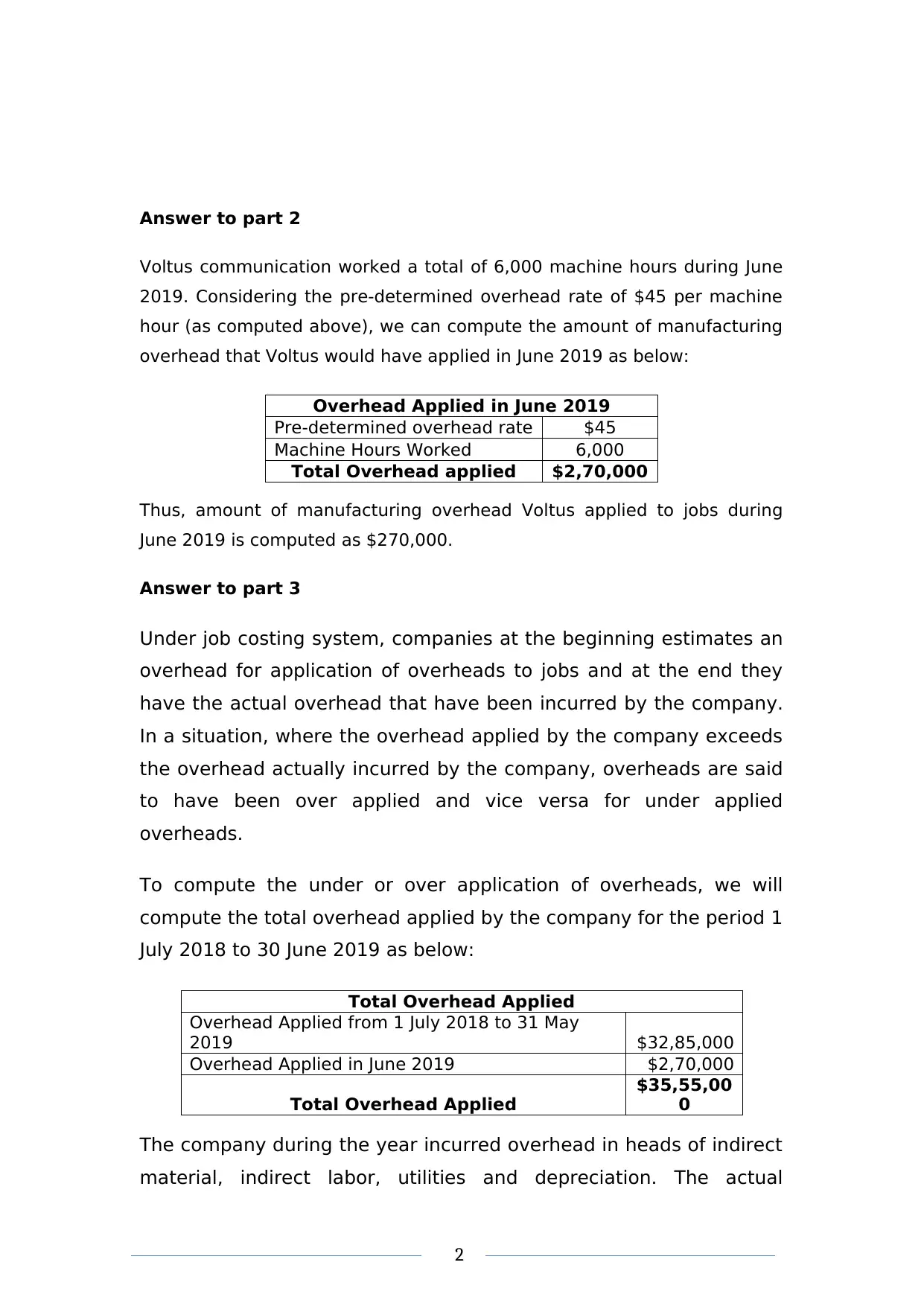
Answer to part 2
Voltus communication worked a total of 6,000 machine hours during June
2019. Considering the pre-determined overhead rate of $45 per machine
hour (as computed above), we can compute the amount of manufacturing
overhead that Voltus would have applied in June 2019 as below:
Overhead Applied in June 2019
Pre-determined overhead rate $45
Machine Hours Worked 6,000
Total Overhead applied $2,70,000
Thus, amount of manufacturing overhead Voltus applied to jobs during
June 2019 is computed as $270,000.
Answer to part 3
Under job costing system, companies at the beginning estimates an
overhead for application of overheads to jobs and at the end they
have the actual overhead that have been incurred by the company.
In a situation, where the overhead applied by the company exceeds
the overhead actually incurred by the company, overheads are said
to have been over applied and vice versa for under applied
overheads.
To compute the under or over application of overheads, we will
compute the total overhead applied by the company for the period 1
July 2018 to 30 June 2019 as below:
Total Overhead Applied
Overhead Applied from 1 July 2018 to 31 May
2019 $32,85,000
Overhead Applied in June 2019 $2,70,000
Total Overhead Applied
$35,55,00
0
The company during the year incurred overhead in heads of indirect
material, indirect labor, utilities and depreciation. The actual
2
Voltus communication worked a total of 6,000 machine hours during June
2019. Considering the pre-determined overhead rate of $45 per machine
hour (as computed above), we can compute the amount of manufacturing
overhead that Voltus would have applied in June 2019 as below:
Overhead Applied in June 2019
Pre-determined overhead rate $45
Machine Hours Worked 6,000
Total Overhead applied $2,70,000
Thus, amount of manufacturing overhead Voltus applied to jobs during
June 2019 is computed as $270,000.
Answer to part 3
Under job costing system, companies at the beginning estimates an
overhead for application of overheads to jobs and at the end they
have the actual overhead that have been incurred by the company.
In a situation, where the overhead applied by the company exceeds
the overhead actually incurred by the company, overheads are said
to have been over applied and vice versa for under applied
overheads.
To compute the under or over application of overheads, we will
compute the total overhead applied by the company for the period 1
July 2018 to 30 June 2019 as below:
Total Overhead Applied
Overhead Applied from 1 July 2018 to 31 May
2019 $32,85,000
Overhead Applied in June 2019 $2,70,000
Total Overhead Applied
$35,55,00
0
The company during the year incurred overhead in heads of indirect
material, indirect labor, utilities and depreciation. The actual
2
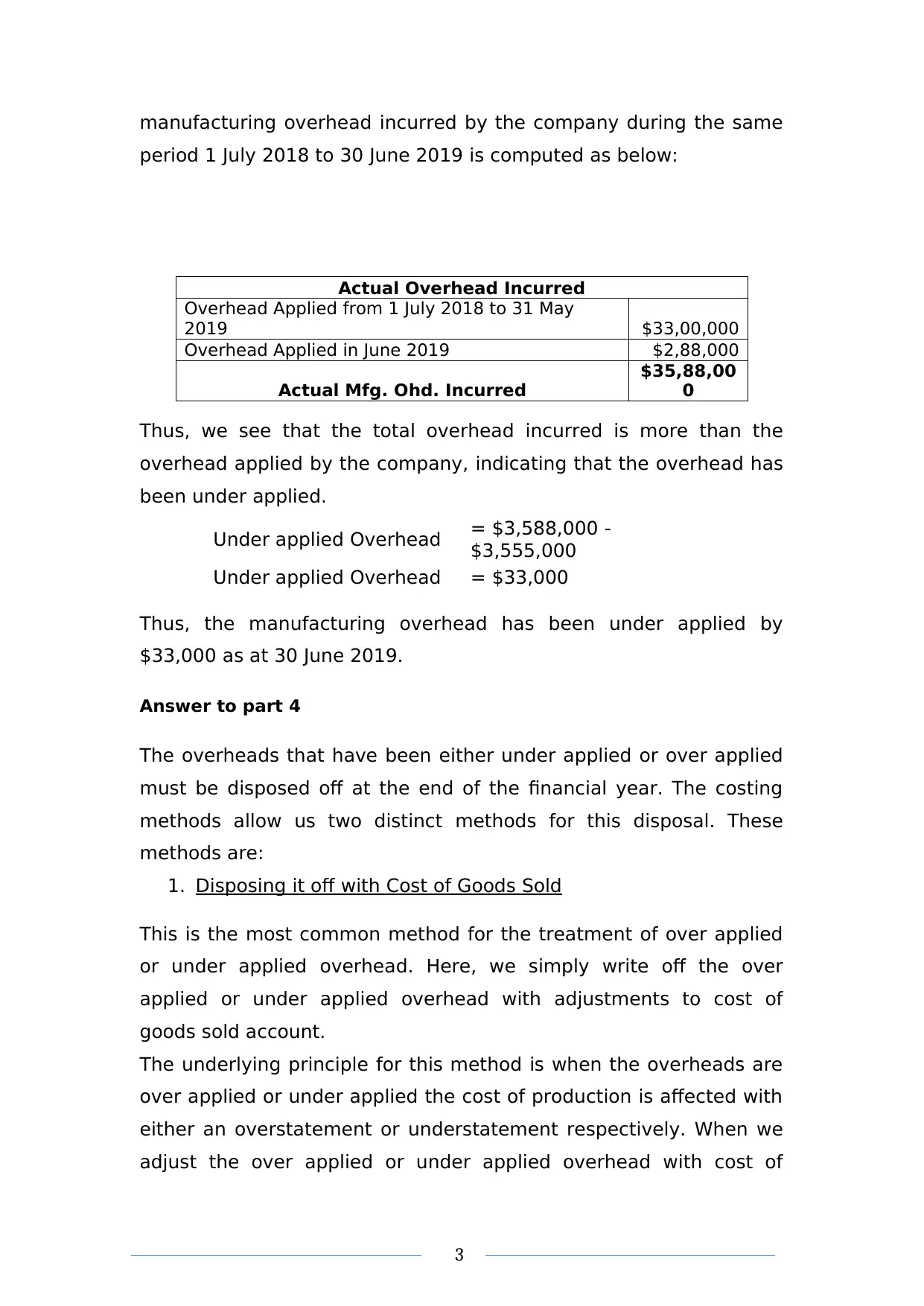
manufacturing overhead incurred by the company during the same
period 1 July 2018 to 30 June 2019 is computed as below:
Actual Overhead Incurred
Overhead Applied from 1 July 2018 to 31 May
2019 $33,00,000
Overhead Applied in June 2019 $2,88,000
Actual Mfg. Ohd. Incurred
$35,88,00
0
Thus, we see that the total overhead incurred is more than the
overhead applied by the company, indicating that the overhead has
been under applied.
Under applied Overhead = $3,588,000 -
$3,555,000
Under applied Overhead = $33,000
Thus, the manufacturing overhead has been under applied by
$33,000 as at 30 June 2019.
Answer to part 4
The overheads that have been either under applied or over applied
must be disposed off at the end of the financial year. The costing
methods allow us two distinct methods for this disposal. These
methods are:
1. Disposing it off with Cost of Goods Sold
This is the most common method for the treatment of over applied
or under applied overhead. Here, we simply write off the over
applied or under applied overhead with adjustments to cost of
goods sold account.
The underlying principle for this method is when the overheads are
over applied or under applied the cost of production is affected with
either an overstatement or understatement respectively. When we
adjust the over applied or under applied overhead with cost of
3
period 1 July 2018 to 30 June 2019 is computed as below:
Actual Overhead Incurred
Overhead Applied from 1 July 2018 to 31 May
2019 $33,00,000
Overhead Applied in June 2019 $2,88,000
Actual Mfg. Ohd. Incurred
$35,88,00
0
Thus, we see that the total overhead incurred is more than the
overhead applied by the company, indicating that the overhead has
been under applied.
Under applied Overhead = $3,588,000 -
$3,555,000
Under applied Overhead = $33,000
Thus, the manufacturing overhead has been under applied by
$33,000 as at 30 June 2019.
Answer to part 4
The overheads that have been either under applied or over applied
must be disposed off at the end of the financial year. The costing
methods allow us two distinct methods for this disposal. These
methods are:
1. Disposing it off with Cost of Goods Sold
This is the most common method for the treatment of over applied
or under applied overhead. Here, we simply write off the over
applied or under applied overhead with adjustments to cost of
goods sold account.
The underlying principle for this method is when the overheads are
over applied or under applied the cost of production is affected with
either an overstatement or understatement respectively. When we
adjust the over applied or under applied overhead with cost of
3
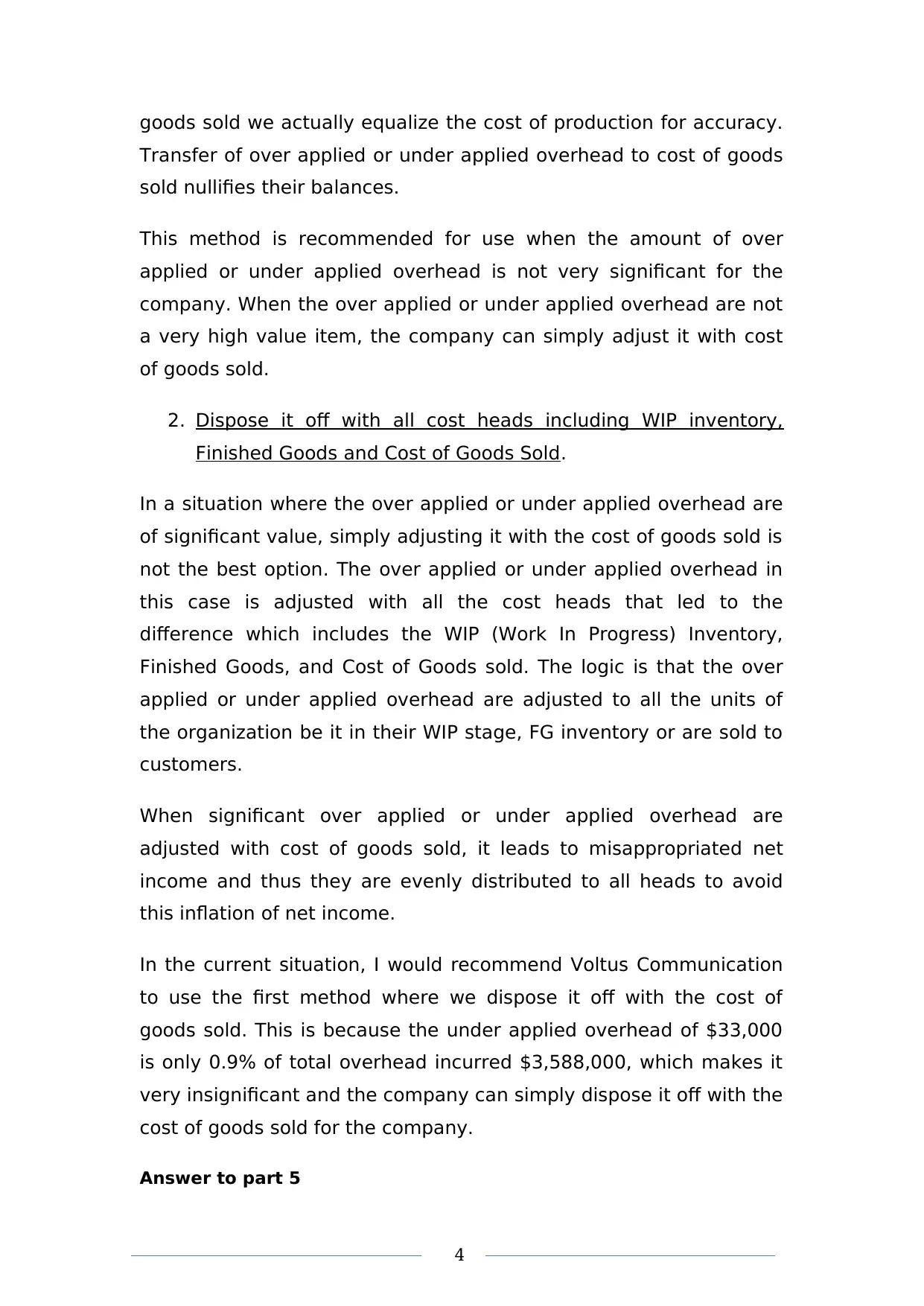
goods sold we actually equalize the cost of production for accuracy.
Transfer of over applied or under applied overhead to cost of goods
sold nullifies their balances.
This method is recommended for use when the amount of over
applied or under applied overhead is not very significant for the
company. When the over applied or under applied overhead are not
a very high value item, the company can simply adjust it with cost
of goods sold.
2. Dispose it off with all cost heads including WIP inventory,
Finished Goods and Cost of Goods Sold.
In a situation where the over applied or under applied overhead are
of significant value, simply adjusting it with the cost of goods sold is
not the best option. The over applied or under applied overhead in
this case is adjusted with all the cost heads that led to the
difference which includes the WIP (Work In Progress) Inventory,
Finished Goods, and Cost of Goods sold. The logic is that the over
applied or under applied overhead are adjusted to all the units of
the organization be it in their WIP stage, FG inventory or are sold to
customers.
When significant over applied or under applied overhead are
adjusted with cost of goods sold, it leads to misappropriated net
income and thus they are evenly distributed to all heads to avoid
this inflation of net income.
In the current situation, I would recommend Voltus Communication
to use the first method where we dispose it off with the cost of
goods sold. This is because the under applied overhead of $33,000
is only 0.9% of total overhead incurred $3,588,000, which makes it
very insignificant and the company can simply dispose it off with the
cost of goods sold for the company.
Answer to part 5
4
Transfer of over applied or under applied overhead to cost of goods
sold nullifies their balances.
This method is recommended for use when the amount of over
applied or under applied overhead is not very significant for the
company. When the over applied or under applied overhead are not
a very high value item, the company can simply adjust it with cost
of goods sold.
2. Dispose it off with all cost heads including WIP inventory,
Finished Goods and Cost of Goods Sold.
In a situation where the over applied or under applied overhead are
of significant value, simply adjusting it with the cost of goods sold is
not the best option. The over applied or under applied overhead in
this case is adjusted with all the cost heads that led to the
difference which includes the WIP (Work In Progress) Inventory,
Finished Goods, and Cost of Goods sold. The logic is that the over
applied or under applied overhead are adjusted to all the units of
the organization be it in their WIP stage, FG inventory or are sold to
customers.
When significant over applied or under applied overhead are
adjusted with cost of goods sold, it leads to misappropriated net
income and thus they are evenly distributed to all heads to avoid
this inflation of net income.
In the current situation, I would recommend Voltus Communication
to use the first method where we dispose it off with the cost of
goods sold. This is because the under applied overhead of $33,000
is only 0.9% of total overhead incurred $3,588,000, which makes it
very insignificant and the company can simply dispose it off with the
cost of goods sold for the company.
Answer to part 5
4
Secure Best Marks with AI Grader
Need help grading? Try our AI Grader for instant feedback on your assignments.
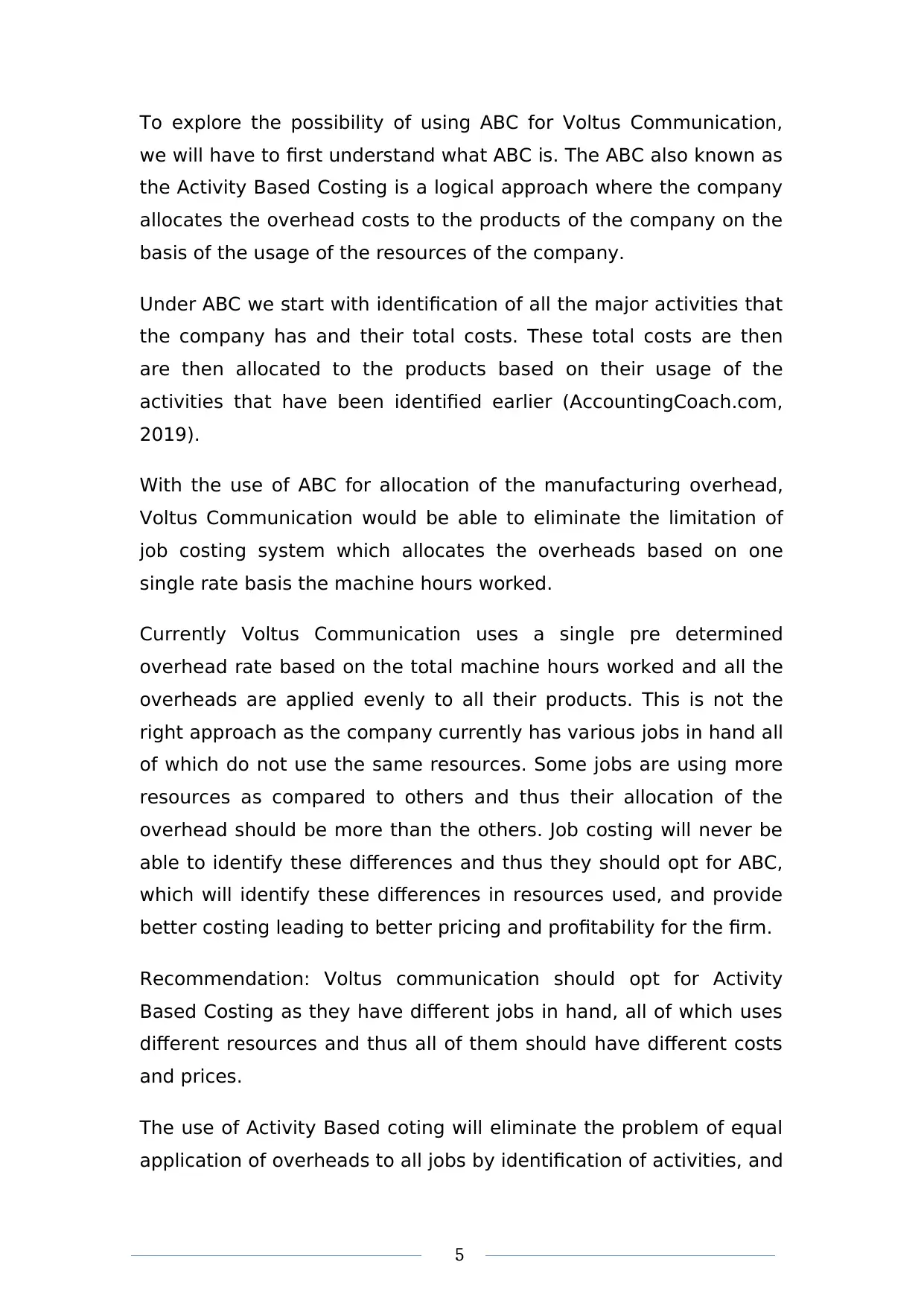
To explore the possibility of using ABC for Voltus Communication,
we will have to first understand what ABC is. The ABC also known as
the Activity Based Costing is a logical approach where the company
allocates the overhead costs to the products of the company on the
basis of the usage of the resources of the company.
Under ABC we start with identification of all the major activities that
the company has and their total costs. These total costs are then
are then allocated to the products based on their usage of the
activities that have been identified earlier (AccountingCoach.com,
2019).
With the use of ABC for allocation of the manufacturing overhead,
Voltus Communication would be able to eliminate the limitation of
job costing system which allocates the overheads based on one
single rate basis the machine hours worked.
Currently Voltus Communication uses a single pre determined
overhead rate based on the total machine hours worked and all the
overheads are applied evenly to all their products. This is not the
right approach as the company currently has various jobs in hand all
of which do not use the same resources. Some jobs are using more
resources as compared to others and thus their allocation of the
overhead should be more than the others. Job costing will never be
able to identify these differences and thus they should opt for ABC,
which will identify these differences in resources used, and provide
better costing leading to better pricing and profitability for the firm.
Recommendation: Voltus communication should opt for Activity
Based Costing as they have different jobs in hand, all of which uses
different resources and thus all of them should have different costs
and prices.
The use of Activity Based coting will eliminate the problem of equal
application of overheads to all jobs by identification of activities, and
5
we will have to first understand what ABC is. The ABC also known as
the Activity Based Costing is a logical approach where the company
allocates the overhead costs to the products of the company on the
basis of the usage of the resources of the company.
Under ABC we start with identification of all the major activities that
the company has and their total costs. These total costs are then
are then allocated to the products based on their usage of the
activities that have been identified earlier (AccountingCoach.com,
2019).
With the use of ABC for allocation of the manufacturing overhead,
Voltus Communication would be able to eliminate the limitation of
job costing system which allocates the overheads based on one
single rate basis the machine hours worked.
Currently Voltus Communication uses a single pre determined
overhead rate based on the total machine hours worked and all the
overheads are applied evenly to all their products. This is not the
right approach as the company currently has various jobs in hand all
of which do not use the same resources. Some jobs are using more
resources as compared to others and thus their allocation of the
overhead should be more than the others. Job costing will never be
able to identify these differences and thus they should opt for ABC,
which will identify these differences in resources used, and provide
better costing leading to better pricing and profitability for the firm.
Recommendation: Voltus communication should opt for Activity
Based Costing as they have different jobs in hand, all of which uses
different resources and thus all of them should have different costs
and prices.
The use of Activity Based coting will eliminate the problem of equal
application of overheads to all jobs by identification of activities, and
5
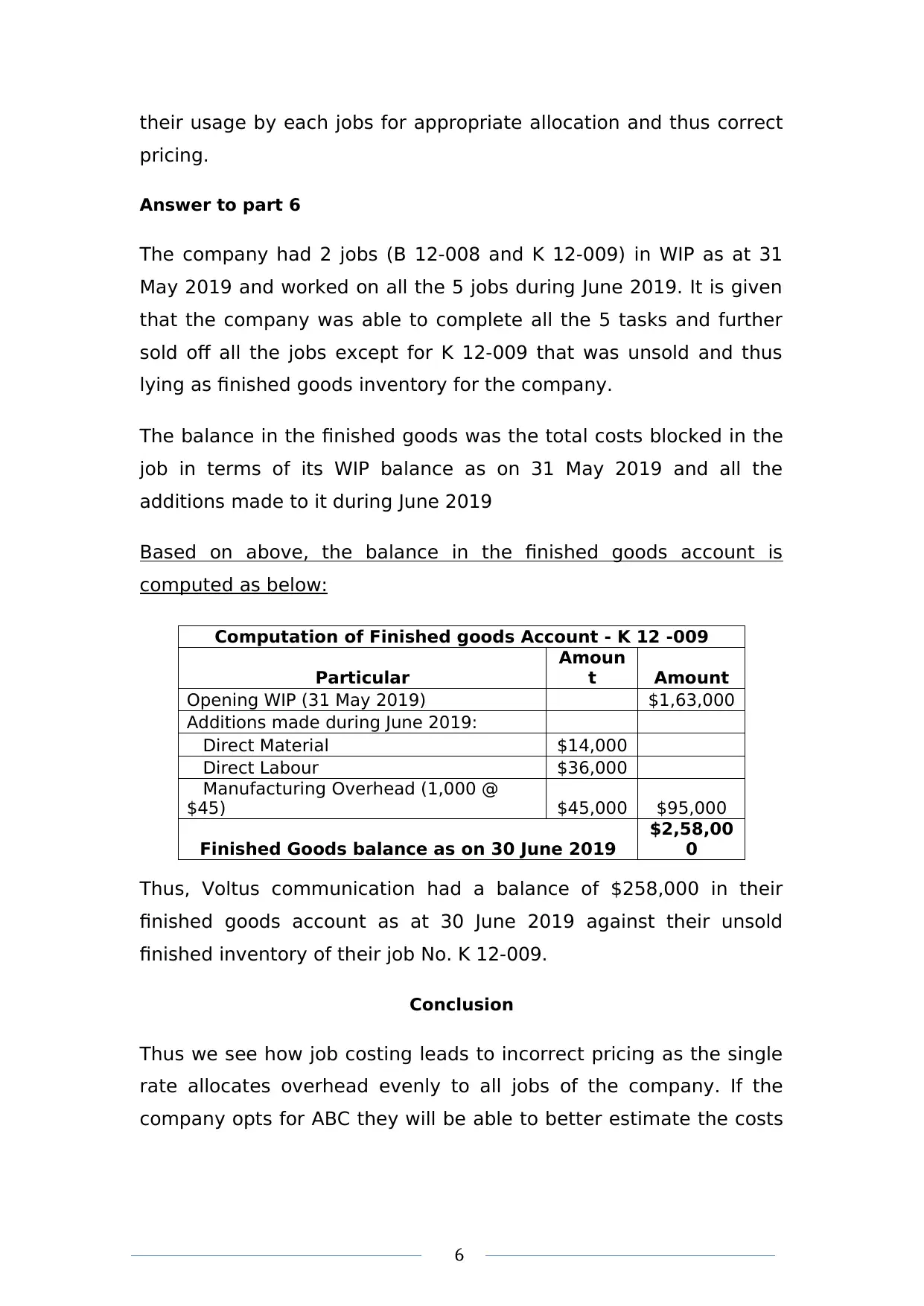
their usage by each jobs for appropriate allocation and thus correct
pricing.
Answer to part 6
The company had 2 jobs (B 12-008 and K 12-009) in WIP as at 31
May 2019 and worked on all the 5 jobs during June 2019. It is given
that the company was able to complete all the 5 tasks and further
sold off all the jobs except for K 12-009 that was unsold and thus
lying as finished goods inventory for the company.
The balance in the finished goods was the total costs blocked in the
job in terms of its WIP balance as on 31 May 2019 and all the
additions made to it during June 2019
Based on above, the balance in the finished goods account is
computed as below:
Computation of Finished goods Account - K 12 -009
Particular
Amoun
t Amount
Opening WIP (31 May 2019) $1,63,000
Additions made during June 2019:
Direct Material $14,000
Direct Labour $36,000
Manufacturing Overhead (1,000 @
$45) $45,000 $95,000
Finished Goods balance as on 30 June 2019
$2,58,00
0
Thus, Voltus communication had a balance of $258,000 in their
finished goods account as at 30 June 2019 against their unsold
finished inventory of their job No. K 12-009.
Conclusion
Thus we see how job costing leads to incorrect pricing as the single
rate allocates overhead evenly to all jobs of the company. If the
company opts for ABC they will be able to better estimate the costs
6
pricing.
Answer to part 6
The company had 2 jobs (B 12-008 and K 12-009) in WIP as at 31
May 2019 and worked on all the 5 jobs during June 2019. It is given
that the company was able to complete all the 5 tasks and further
sold off all the jobs except for K 12-009 that was unsold and thus
lying as finished goods inventory for the company.
The balance in the finished goods was the total costs blocked in the
job in terms of its WIP balance as on 31 May 2019 and all the
additions made to it during June 2019
Based on above, the balance in the finished goods account is
computed as below:
Computation of Finished goods Account - K 12 -009
Particular
Amoun
t Amount
Opening WIP (31 May 2019) $1,63,000
Additions made during June 2019:
Direct Material $14,000
Direct Labour $36,000
Manufacturing Overhead (1,000 @
$45) $45,000 $95,000
Finished Goods balance as on 30 June 2019
$2,58,00
0
Thus, Voltus communication had a balance of $258,000 in their
finished goods account as at 30 June 2019 against their unsold
finished inventory of their job No. K 12-009.
Conclusion
Thus we see how job costing leads to incorrect pricing as the single
rate allocates overhead evenly to all jobs of the company. If the
company opts for ABC they will be able to better estimate the costs
6
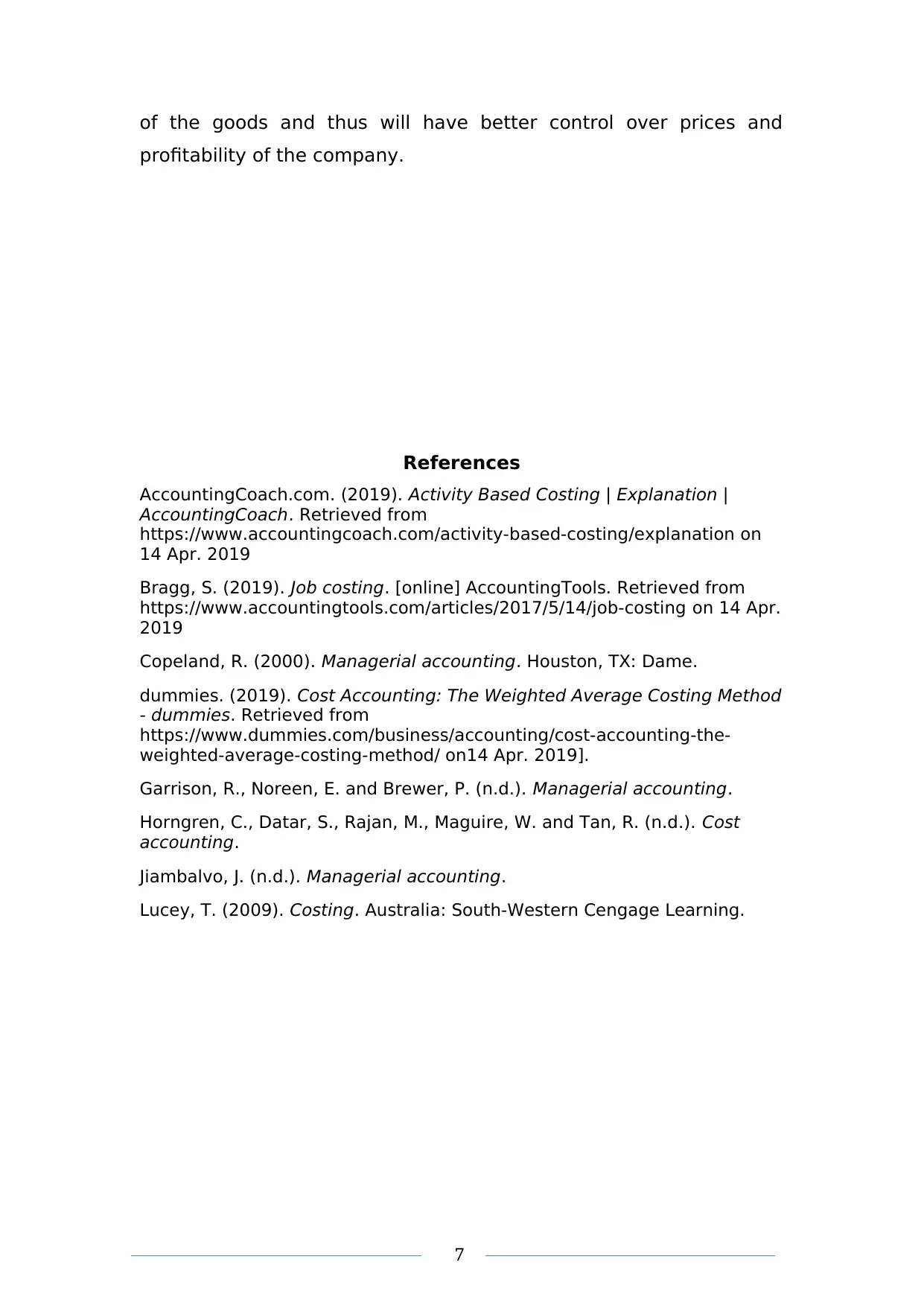
of the goods and thus will have better control over prices and
profitability of the company.
References
AccountingCoach.com. (2019). Activity Based Costing | Explanation |
AccountingCoach. Retrieved from
https://www.accountingcoach.com/activity-based-costing/explanation on
14 Apr. 2019
Bragg, S. (2019). Job costing. [online] AccountingTools. Retrieved from
https://www.accountingtools.com/articles/2017/5/14/job-costing on 14 Apr.
2019
Copeland, R. (2000). Managerial accounting. Houston, TX: Dame.
dummies. (2019). Cost Accounting: The Weighted Average Costing Method
- dummies. Retrieved from
https://www.dummies.com/business/accounting/cost-accounting-the-
weighted-average-costing-method/ on14 Apr. 2019].
Garrison, R., Noreen, E. and Brewer, P. (n.d.). Managerial accounting.
Horngren, C., Datar, S., Rajan, M., Maguire, W. and Tan, R. (n.d.). Cost
accounting.
Jiambalvo, J. (n.d.). Managerial accounting.
Lucey, T. (2009). Costing. Australia: South-Western Cengage Learning.
7
profitability of the company.
References
AccountingCoach.com. (2019). Activity Based Costing | Explanation |
AccountingCoach. Retrieved from
https://www.accountingcoach.com/activity-based-costing/explanation on
14 Apr. 2019
Bragg, S. (2019). Job costing. [online] AccountingTools. Retrieved from
https://www.accountingtools.com/articles/2017/5/14/job-costing on 14 Apr.
2019
Copeland, R. (2000). Managerial accounting. Houston, TX: Dame.
dummies. (2019). Cost Accounting: The Weighted Average Costing Method
- dummies. Retrieved from
https://www.dummies.com/business/accounting/cost-accounting-the-
weighted-average-costing-method/ on14 Apr. 2019].
Garrison, R., Noreen, E. and Brewer, P. (n.d.). Managerial accounting.
Horngren, C., Datar, S., Rajan, M., Maguire, W. and Tan, R. (n.d.). Cost
accounting.
Jiambalvo, J. (n.d.). Managerial accounting.
Lucey, T. (2009). Costing. Australia: South-Western Cengage Learning.
7
1 out of 7
Related Documents
Your All-in-One AI-Powered Toolkit for Academic Success.
+13062052269
info@desklib.com
Available 24*7 on WhatsApp / Email
![[object Object]](/_next/static/media/star-bottom.7253800d.svg)
Unlock your academic potential
© 2024 | Zucol Services PVT LTD | All rights reserved.





